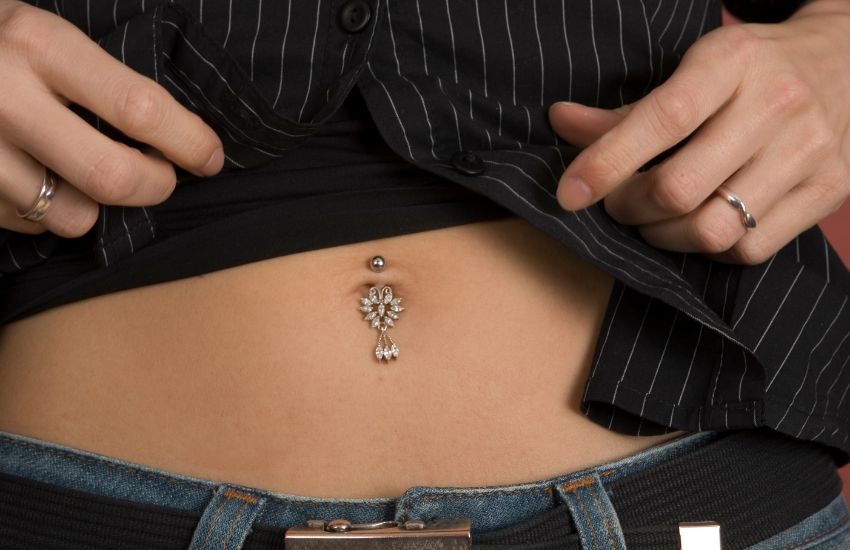
Table of Contents
The belly button piercing (also known as the navel piercing) is one of the most common and popular body piercings today. It first gained popularity in the West in 1993 when model Christy Turlington revealed her piercing at a fashion show in London and since then its popularity has continued to increase over the years.
One reason to choose belly button piercings is that they tend to highlight the abdomen, giving you a sexy look. If you’re looking for a piercing to show off your cool and funky side, why not go for a belly button piercing? Here’s everything you need to know about it.
What is a Belly Button Piercing?

A belly button piercing (or a navel piercing) is located in, around, or through the navel. Most belly button piercings are done just above the belly button.
The name of this piercing can be misleading since it’s not actually the belly button itself that gets pierced. Instead, it’s the skin surrounding it.
Although it seems quite easy and straightforward, it can be a complicated piercing if done by an unskilled piercer. Because there are many blood vessels and nerves in that area that should be carefully avoided when piercing, a perforation in the wrong spot can lead to issues.
Origin and History of Navel Piercings
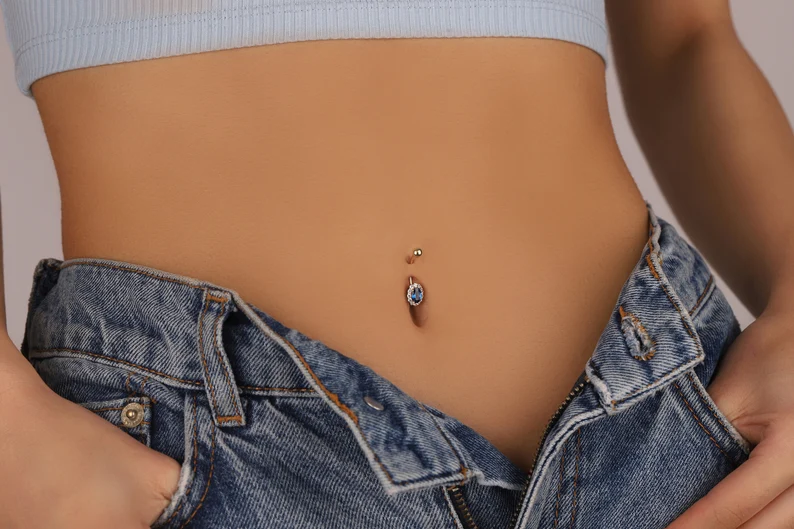
Navel piercings, while appearing as a contemporary fashion, have origins in ancient civilizations. Each culture has uniquely embraced body adornments throughout history. For instance, records from Ancient Egypt show pharaohs and elites donning navel jewelry to symbolize their divine connections and high status.
In the 20th century, Western cultures started embracing navel piercings. These piercings made a comeback in the alternative and punk scenes of the 1970s and 1980s. Yet, their mainstream breakthrough came in the 1990s. Many attribute this surge in popularity to the Aerosmith “Cryin'” music video, in which Alicia Silverstone pierces her navel.
The fashion and entertainment industry then heavily promoted this trend, with many celebrities showcasing their navel piercings. Over time, the techniques, styles, and jewelry associated with navel piercing have evolved. Now, people see navel piercings as a form of personal expression and a tribute to historical traditions.
How is the Navel Piercing Done?

When you go in for your piercing, your piercer will first examine your belly button and the area surrounding it to make sure that it’s safe to go ahead with the piercing. The type of navel you have will influence the piercing and how complex the piercing will be.
Once your piercer assesses the area and gives you the green light, you will be asked to choose the jewelry you want to adorn your piercing. Your piercer will clean and sterilize your belly button and the area surrounding it, marking the spot with a surgical marker.
Next, he will pierce the spot with a hollow needle and quickly insert the jewelry into the hole. Once the jewelry is in and secures that’s it! You’re done and all ready to go!
What’s the Best Jewelry for Belly Button Piercing?
When choosing your jewelry, take your piercer’s advice into consideration as they generally have a better idea about what type of jewelry would suit you best especially when your piercing is still healing.
Choosing the right metals for your jewelry is important as not all metals are suitable for everyone. The safest metals are titanium, gold, silver, and nickel-free metals as they are hypoallergenic and biocompatible, so opt for these to avoid unwanted complications.
Lucky for you, there are several types of jewelry that you could adorn your piercing with so let’s have a look at them!
1. Curved Barbell
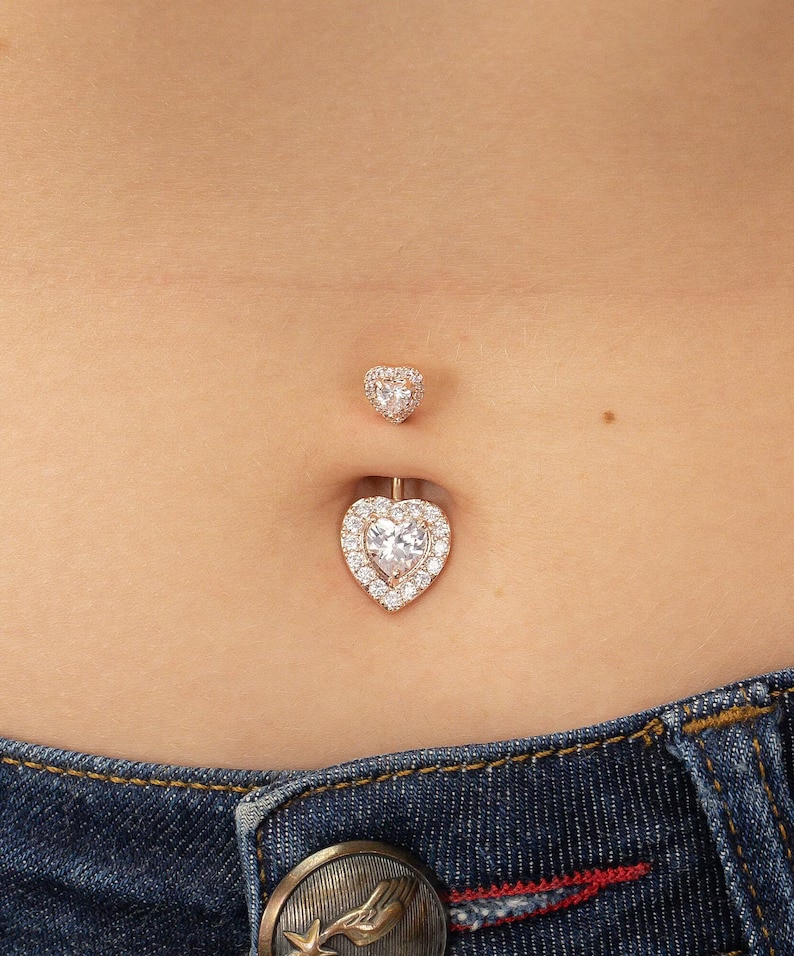
This is one of the most common types of jewelry that’s used for belly button piercings. The gentle curve of this barbell offers a stylish look and works well in your navel, which has natural curves. If you prefer something more interesting than a plain curved barbell with balls on the ends, you could try one with spikes or diamonds if you like.
2. Non-Dangle Curved Barbells
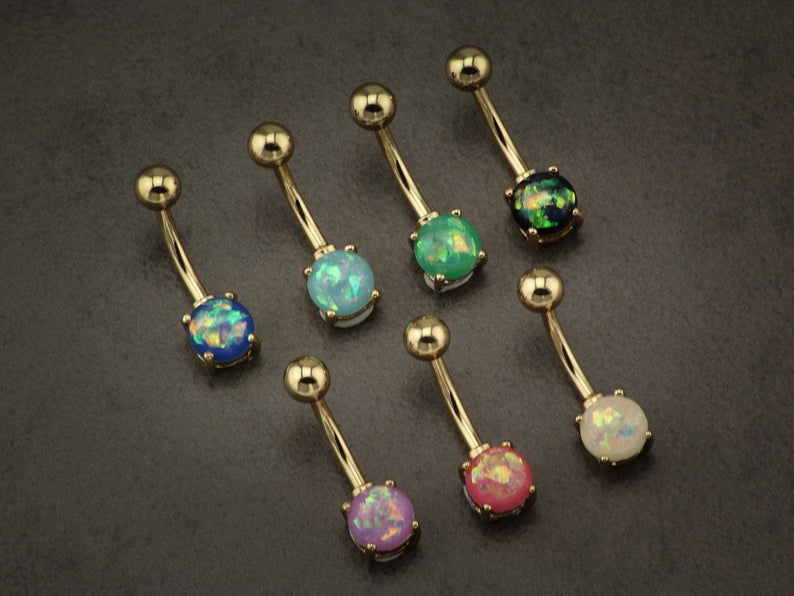
These are great for everyday wear and come in a variety of styles and colors from basic to fabulous. Made from a range of materials, curved barbells can be adorned with gemstones and are also very comfortable to wear.
3. Dangle Curved Barbells
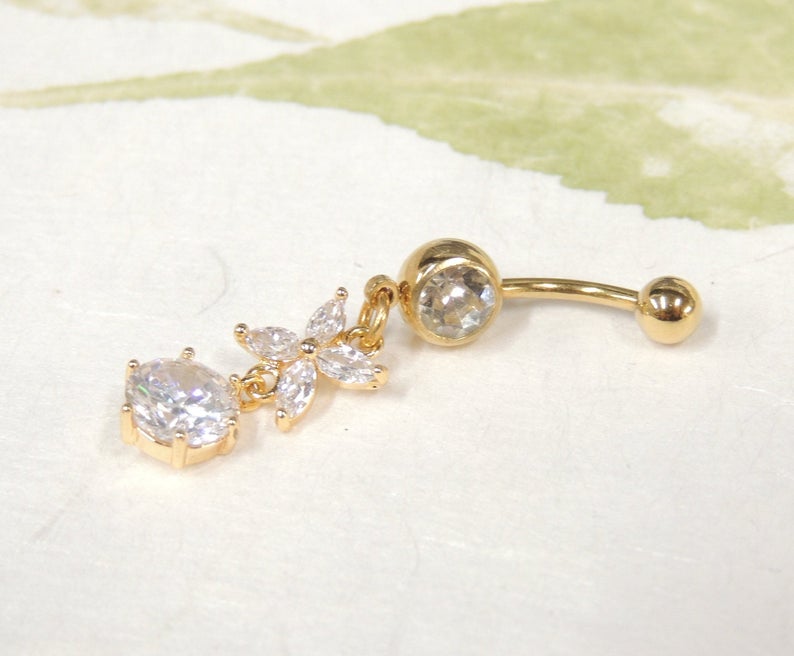
The difference between these and the non-dangle belly rings is that they have unique charms on them that dangle about when you move. You can find these also in a variety of styles, ranging from simple to elaborate. You can opt for the most basic style for everyday wear and choose a flashy one whenever you want to show it off. Take your pick!
4. Reverse or Top-Down Curved Barbells
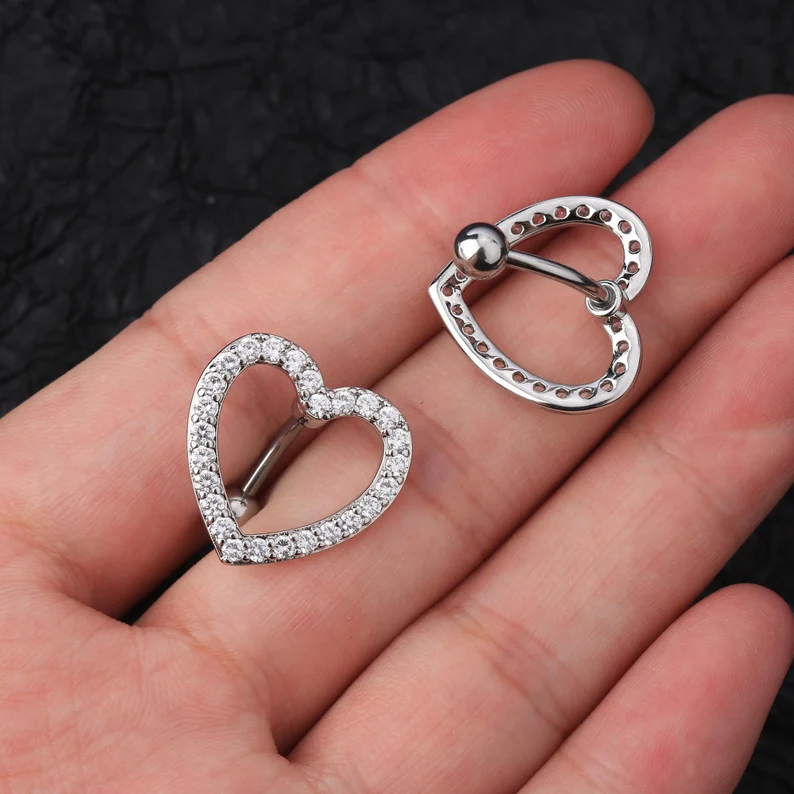
Reverse belly rings are quite the stylish trend in belly button piercing jewelry. They are different from regular dangle belly rings in that the charm hangs from the top of the navel and down over the belly button, accentuating the length of the navel. You can find these in all designs from simple to elaborate and intricate.
5. Captive Bead Rings or Circular Barbells
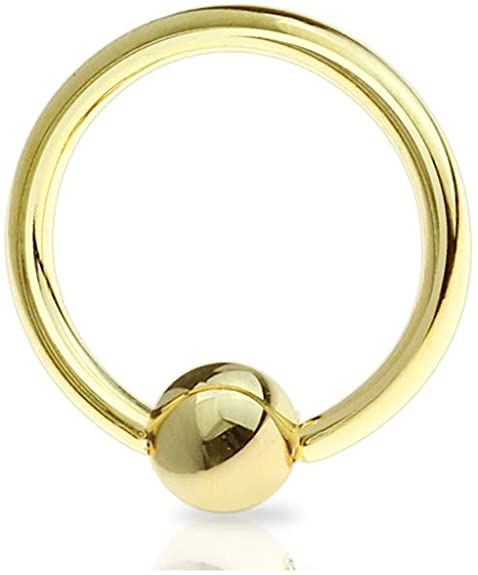
If you’d prefer to have a simple and understated look why not go for a captive bead ring or a circular barbell instead? It’s perfect for a classic look as it’s a simple hoop that comes with a bead to keep your jewelry safely in place. The fit is easy and the design is gorgeous, yet practical.
6. Twister Spiral Navel Rings

As the name suggests, these belly rings are a twisted spiral that you can insert into your piercing and secure carefully with a screw-on ball. These rings offer a double-pierced look without you actually having to get a second piercing and serve as a great alternative to a curved or circular barbell.
Belly Button Piercing Pain and Aftercare

Most people claim that the belly button piercing ranks low on the pain scale, hurting far less than an earlobe piercing. You’ll feel a stinging sensation for a few seconds but it’s far less prolonged than some other piercings, like daith piercings for example. The belly button area isn’t as sensitive as most other areas like the nose or the lips for instance. This means less pain and sensitivity.
While pain is a subjective experience and everyone’s pain threshold is different, you will most likely be able to handle this one. Just breathe and it will be over before you know it.
One of the main downsides of navel piercings is that it takes longer than other piercings to heal. In fact, it can take anywhere from 6 months to a year. The best you can do to speed up the healing process is to stick to the rules of aftercare.
1. Clean your piercing regularly
Cleaning at least two or three times a day with a saline solution should minimize the risk of infection. Keeping your piercing clean is crucial so don’t skip it or you might find yourself with an infected piercing to deal with. Also, wash your hands thoroughly before you touch your new piercing.
2. Avoid touching or playing around with the piercing
Though it can be tempting to play around with your new jewelry, constant movement will irritate the piercing and impede the healing process so do the best you can to keep your hands away from it and only touch it when you absolutely have to.
3. Wear loose clothing
Tight clothing can snag on your jewelry so try wearing loose clothing instead as it will also give your piercing a chance to breathe.
4. Avoid using products with harsh chemicals
Avoid using creams or other products on or around your piercing as they may contain harsh chemicals that can irritate the piercing or even cause allergies.
5. Avoid swimming in pools, lakes, or pretty much any body of water
This is unsanitary and unsafe for your piercing. Submerging your piercing in water with chemicals or contaminants is a sure way to wind up with an infection.
During the healing process, it’s important to keep an eye on your piercing to make sure that it’s healing properly. You should be able to tell if it’s infected because it will look red, slightly swollen, give off an odor, or may even have pus oozing from the site. If the area feels hot to the touch and you feel some tenderness, seek medical attention immediately as these are tell-tale signs of an infection.
What are the Pros and Cons of Belly Button Piercings?
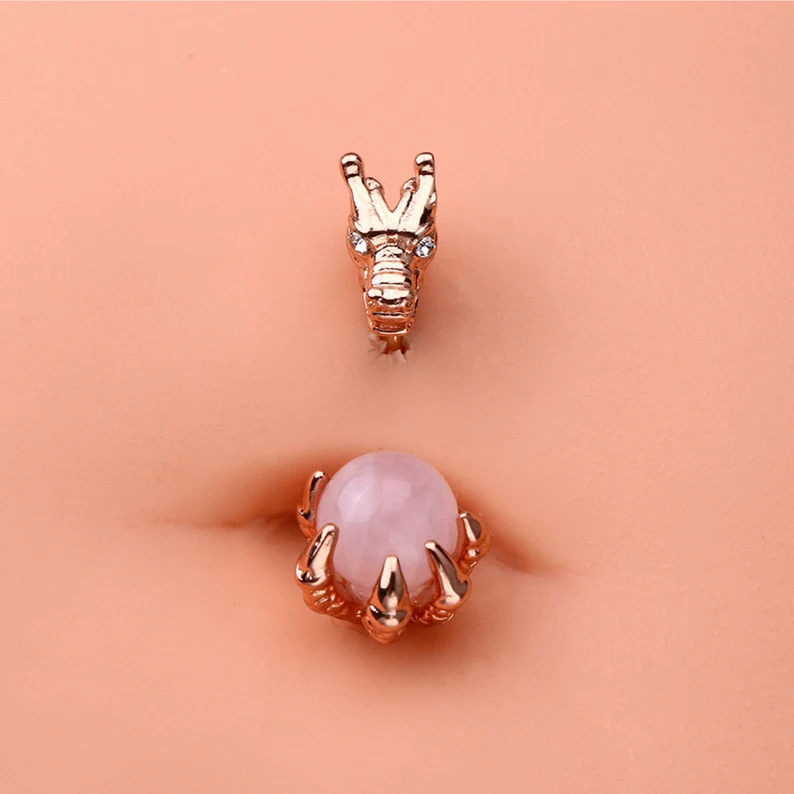
Before you decide on getting your belly button piercing, you might want to weigh the pros and cons first so that you’ll know what to expect and it’ll help you figure out if it’s the right piercing for you.
Belly Button Piercing Pros
- It looks stunning!
- It’s less painful than most other piercings.
- You have lots of jewelry options to dress it up with!
- It’s easy to hide if necessary
Belly Button Piercing Cons
- It can take longer than other piercings to heal.
- It can easily get caught on clothes
- There’s a risk of migration and rejection.
Myths about Belly Button Piercings

There are several myths and misconceptions surrounding belly button jewelry and navel piercings. Here are some of the most common:
1. “Belly button piercings only suit flat stomachs.”
Beauty and self-expression have no size. People of all body types can rock a navel piercing if they want to.
2. “You can’t get pregnant or it’s dangerous to be pregnant with a navel piercing.”
Pregnancy doesn’t prestopvent you from having a navel piercing, but the piercing might need extra care or a change in jewelry (like switching to a flexible PTFE bar) to accommodate the stretching skin.
3. “Navel piercings take only a few weeks to heal.”
In reality, while the surface might appear healed within a few weeks, full healing can take anywhere from six months to a year.
4. “All belly button jewelry fits everyone.”
Anatomical differences mean some people might be better suited to specific types of jewelry or piercing placements. It’s important to consult with a professional piercer to get advice on this.
5. “Using alcohol or hydrogen peroxide will speed up the healing process.”
These substances can be too harsh and may delay healing. Saline solution is usually recommended for cleaning navel piercings.
6. “Navel piercings easily reject or migrate.”
While rejection and migration can occur with any piercing, using high-quality jewelry and following proper aftercare can significantly reduce the risks.
Where to Buy Belly Button Piercing Jewelry
When searching for belly button piercing jewelry, many places offer a variety of styles and safety options. Two popular online platforms to consider are Amazon and Etsy:
- Amazon: A massive online store, Amazon has a broad range of belly button jewelry, from basic to fancy designs. Their user reviews help buyers gauge product quality, and with Amazon Prime, fast shipping is available.
- Etsy: For those wanting unique or handmade jewelry, Etsy connects you with artisans. Many sellers use top-notch materials and even allow customization. Purchasing here also supports small crafters.
- Piercing Studios: Going to professional studios ensures you get safe, quality jewelry. Plus, experts can advise on fit and style.
Wrapping Up
Now that you’ve got all the information you need, take a moment to decide whether this piercing is the right choice for you. Piercings are a form of self-expression so you should choose what you’re comfortable with and what best suits you. If you feel that this is the right piercing for you, go ahead, get it done and enjoy your gorgeous new look!









